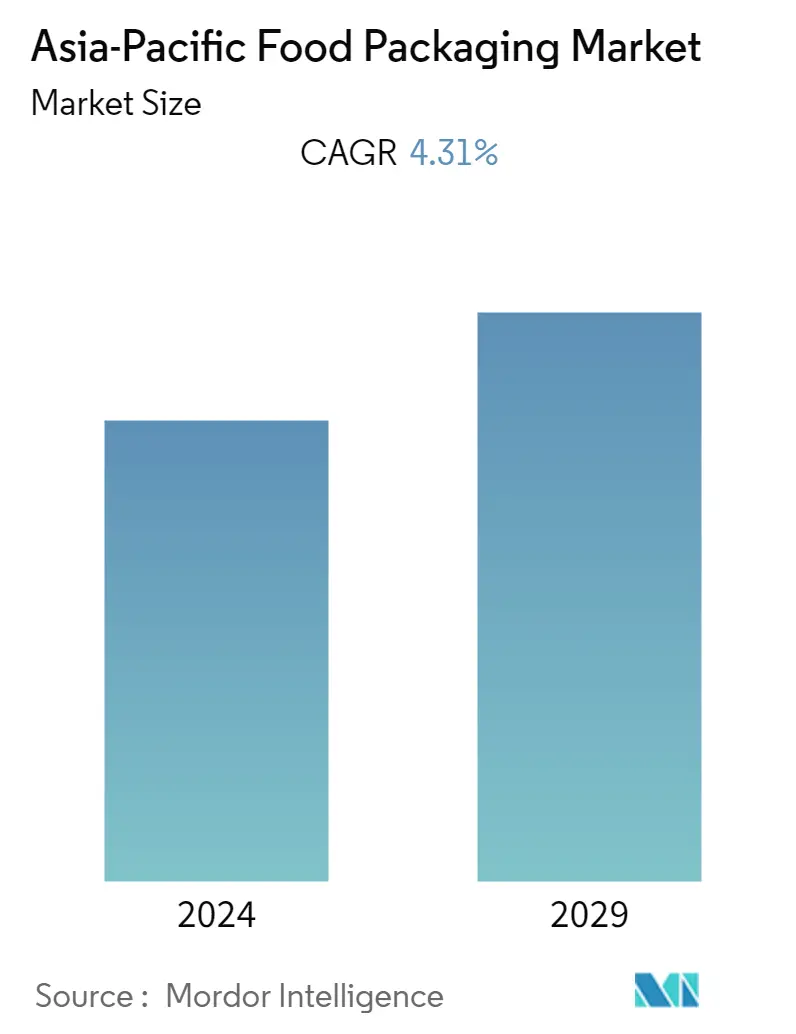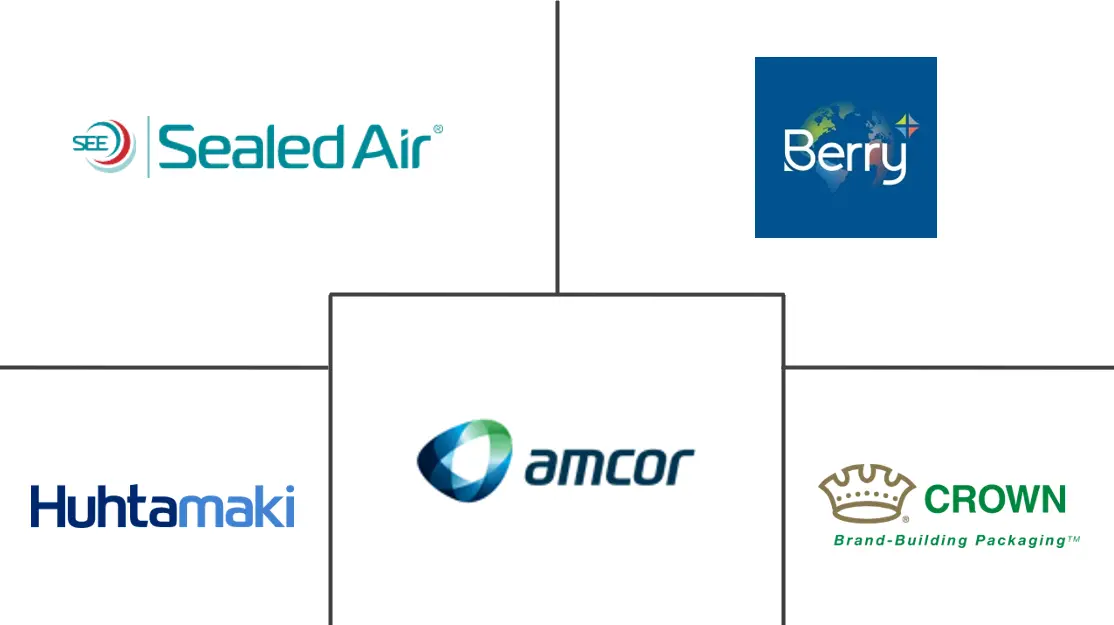Market Size of Asia-Pacific Food Packaging Industry

| Study Period | 2019 - 2029 |
| Base Year For Estimation | 2023 |
| Forecast Data Period | 2024 - 2029 |
| Historical Data Period | 2019 - 2022 |
| CAGR | 4.31 % |
| Market Concentration | Low |
Major Players
*Disclaimer: Major Players sorted in no particular order |
APAC Food Packaging Market Analysis
The Asia-Pacific food packaging market is expected to register a CAGR of 4.31% over the forecast period 2022 - 2027. Asia-Pacific has been experiencing positive growth in the food packaging market and is estimated to witness significant growth over the forecast period. The disposable income of consumers in the region has seen significant growth, which has increased the standard of living of people in the region.
- The increasing exports of fruits and vegetables in Asia-pacific are increasing the growth of the market. The world imports of fruit and vegetables have increased by 17.6%, and imports of fruits and vegetables in the Asia Pacific region increased by 51.6%.
- Moreover, in a country such as India, the growing demand for online food ordering is increasing, which is pushing the usage of packaged food boxes in the food packaging market. For instance, in February 2022, Zomato, one of the prominent food delivery companies, said that the average monthly active food delivery restaurants have grown by 6x and average monthly transacting customers have grown by 13x on Zomato over the past 5 years.
- The changes in the lifestyle of the people and changing food preferences of consumers, along with the increasing population in developing nations, will drive the growth of the market in the forecasted period.
- The growing preference of people for processed food due to the surging working population, rising disposable incomes, and hectic lifestyles, to shifts in population dynamics from rural to urban areas is also driving the food packaging market.
- New packaging technologies, such as active packaging, intelligent packaging, and engineering science, have evolved over the years, which enables the flexible packaging of food products. Companies are adopting eco-friendly packaging by using biodegradable packaging material which can be recycled, renewed, and reused.
- Due to increased dry food procurement fueled by hygiene concerns, the emergence of COVID-19 sparked a demand for canned food across the Asia Pacific area. However, due to a total lockdown and stoppage of manufacturing activities, the industry was unable to fully benefit from the sudden demand surge, which hampered the market's growth in 2020. Furthermore, because health worries are anticipated to persist even after the disease outbreak has subsided, the market is expected to increase steadily in the following years.
APAC Food Packaging Industry Segmentation
Food packaging plays an essential role in preserving and transporting food items to their desired location without affecting the taste or quality. It protects the contents from toxins and moisture, prevents the food products from spillage, and tampering, and helps retain their shape and quality. The Asia-Pacific food packaging market is segmented by material type, product type, end-user type, and country.
| By Material Type | ||||
| ||||
| Paper and Paperboard | ||||
| Metal | ||||
| Glass |
| By Product Type | |
| Bottles and Containers | |
| Cartons and Pouches | |
| Cans | |
| Films and Wraps | |
| Caps and Closures | |
| Other Product Types |
| By End-user Type | |
| Fruits and Vegetables | |
| Meat and Poultry | |
| Dairy Products | |
| Bakery and Confectionery | |
| Other end-users |
| By Country | |
| China | |
| India | |
| Japan | |
| South Korea | |
| Indonesia | |
| Thailand | |
| Rest of APAC |
Asia-Pacific Food Packaging Market Size Summary
The Asia-Pacific food packaging market is poised for substantial growth, driven by increasing disposable incomes and changing consumer lifestyles. The region's expanding middle class and urbanization are contributing to a shift in food preferences, with a growing demand for processed and packaged foods. This trend is further amplified by the rise in online food ordering, particularly in countries like India, where companies such as Zomato have reported significant growth in food delivery services. The market is also benefiting from advancements in packaging technologies, including active and intelligent packaging, which enhance the flexibility and sustainability of food packaging solutions. The adoption of eco-friendly materials, such as biodegradable packaging, is gaining traction as companies strive to meet evolving consumer and regulatory demands.
The flexible packaging sector, in particular, is experiencing robust growth due to its cost-effectiveness, durability, and aesthetic appeal. This segment is predominantly driven by the food and pharmaceutical industries, with flexible plastic packaging being a dominant choice in India. The increasing preference for convenient and sustainable packaging solutions is encouraging companies to explore recyclable and recycled-content options. Innovations in packaging materials, such as formable paper, are gaining popularity for their superior barrier properties and reduced plastic usage. The market's expansion is supported by the growth of international trade in packaging materials and machinery, facilitated by India's commitment to global trade agreements. As the market becomes more competitive, companies are focusing on product customization and compliance with environmental regulations to enhance their market share.
Asia-Pacific Food Packaging Market Size - Table of Contents
-
1. MARKET INSIGHTS
-
1.1 Market Overview
-
1.2 Industry Attractiveness - Porter's Five Force Analysis
-
1.2.1 Bargaining Power of Suppliers
-
1.2.2 Bargaining Power of Consumers
-
1.2.3 Threat of New Entrants
-
1.2.4 Threat of Substitutes
-
1.2.5 Intensity of Competitive Rivalry
-
-
1.3 Industry Value Chain Analysis
-
-
2. MARKET SEGMENTATION
-
2.1 By Material Type
-
2.1.1 Plastic
-
2.1.1.1 Rigid
-
2.1.1.2 Flexible
-
-
2.1.2 Paper and Paperboard
-
2.1.3 Metal
-
2.1.4 Glass
-
-
2.2 By Product Type
-
2.2.1 Bottles and Containers
-
2.2.2 Cartons and Pouches
-
2.2.3 Cans
-
2.2.4 Films and Wraps
-
2.2.5 Caps and Closures
-
2.2.6 Other Product Types
-
-
2.3 By End-user Type
-
2.3.1 Fruits and Vegetables
-
2.3.2 Meat and Poultry
-
2.3.3 Dairy Products
-
2.3.4 Bakery and Confectionery
-
2.3.5 Other end-users
-
-
2.4 By Country
-
2.4.1 China
-
2.4.2 India
-
2.4.3 Japan
-
2.4.4 South Korea
-
2.4.5 Indonesia
-
2.4.6 Thailand
-
2.4.7 Rest of APAC
-
-
Asia-Pacific Food Packaging Market Size FAQs
What is the current Asia-Pacific Food Packaging Market size?
The Asia-Pacific Food Packaging Market is projected to register a CAGR of 4.31% during the forecast period (2024-2029)
Who are the key players in Asia-Pacific Food Packaging Market?
Sealed Air Corporation, Berry Global Inc., Huhtamaki Group, Amcor plc and Crown Holdings Inc. are the major companies operating in the Asia-Pacific Food Packaging Market.

